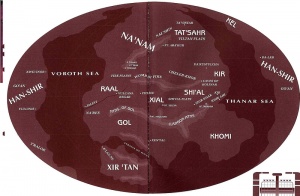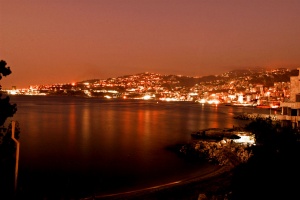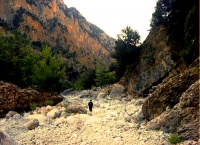More actions
| Line 100: | Line 100: | ||
It was also during this time that temples and monasteries of healer orders began to crop up along the coast and in the Llangon foothills, some of them dedicated to the mind-arts of biofeedback control which is part of basic Vulcan education today. | It was also during this time that temples and monasteries of healer orders began to crop up along the coast and in the Llangon foothills, some of them dedicated to the mind-arts of biofeedback control which is part of basic Vulcan education today. | ||
Claims that Khomi adepts founded the famous monastery at [[Shi'Al#T'Shen|T'Shen]] may be exaggerated, but there is proof of a lively exchange between the healer monks dating back | Claims that Khomi adepts founded the famous monastery at [[Shi'Al#T'Shen|T'Shen]] may be exaggerated, but there is proof of a lively exchange between the healer monks dating back millennia before the [[Time of Awakening]]. | ||
Even with the re-emergence of High Houses some time prior to the [[Age of Expansion]] the minor nobles retained a measure of autonomy and the by then much grown city of Te'Rashar became a center of medical research by attaching a university to its already reputable hospital. | Even with the re-emergence of High Houses some time prior to the [[Age of Expansion]] the minor nobles retained a measure of autonomy and the by then much grown city of Te'Rashar became a center of medical research by attaching a university to its already reputable hospital. | ||
Revision as of 15:29, 18 November 2015

A peninsula on the southeasternmost part of the Na'Nam Continent, Khomi province shares a border with Kir and Shi'Al to the north and Gol to the west. Except for the Llangon Mountains, the savannah-like plains to the west and a small fertile strip along the coast, Khomi primarily consists of flat and barren hardpan; cracked and canyoned by regular tectonic activity. The region's wealth consists almost exclusively in its large mineral deposits and the trade conducted by its few coastal cities. However, one should also note that the wines produced in the hills near Te’Rashar are prized for their unique flavors and exquisite quality and the city's university is second only to the great learning centers of Shi'Kahr.
History

Due to its wealth in ores and minerals on a planet where weapons were always in demand and supplies short, Khomi province has for millennia been saved from extensive warfare only due to its unique geological position. Protected by mountains to the north and west and a jagged coast most everywhere else, the ruling clans held the peninsula unchallenged until roughly the 37th century of the Vulcan calendar (4700 BCE by terran standard).
With the inevitable advances in warfare and the rise of powerful clans in Gol and Shi'Al, the borders began to shift and skirmishes increased. However, it was not until an eruption of Mount Tar'Hana and a series of earthquakes opened new passes in the forbidding mountains that a short lived alliance of western clans succeeded in laying claim to several mines and plundering coastal cities.
The following decades were marked by near constant war as the indigenous houses sought to regain sovereignty but were hampered by shortness of supplies and raw materials while the conquering forces were plagued by the unpredictability of their superiors who demanded the mining operations to remain in full force while troops were overextended and materiel only arrived sporadically.
As a result of nearly a century of scorched earth warfare and constant raids, the population began to doubt their leaders' ability to restore their lands and the province erupted into full civil war.
It was not until another dozen years later that one of the occupying forces suffered a devastating defeat during a campaign to invade Kir and subsequently had to withdraw their forces, giving the battered and war-torn houses of Khomi a chance to regain valuable strongholds and mines. However, with their economy in shambles and wide-spread starvation resulting low birth rates, the clans were forced into unfavorable alliances and much valuable land that had been hard fought for was bargained away to keep the old rulers in power.
Rise and Fall of T'Velah
Born to one of the most powerful coastal clans of Khomi, T'Velah was destined to become matriarch simply by virtue of cunning and utter ruthlessness. Having spent her youth experiencing the devastating conquest of her ancestral home Ari'Kel and the poverty resulting from it, she was one of the youngest matriarchs ever to ascend to power after successfully assasinating the rival clan's nobility and seducing the captain in command of their guards. For over a century, the fortress and city of Ari'Kel remained firmly in T'Velah's hands while the population dwindled and if not for a fateful meeting during the last years of the civil war, T'Velah might have remained no more than a footnote in ancient scrolls.

Historical records clearly indicate that the young lieutenant who caught the matriarch's attention with his successful defense of vital farmsteads with a mere handful of starving troops was of minor, impoverished nobility and would never have been considered for a high position in the clan if not for his strategic genius and uncanny ability to inspire loyalty in troops that were weary from endless wars, underfed and ill equipped. The lieutenant's dazzling rise to the matriarch's warlord who remained undefeated throughout his life is the subject of many legends on Vulcan, just as the stoires of his campaigns remain required reading at the Institute of Defensive Arts.
After merely three decades, the province's coastline and few fertile areas were firmly in T'Velah's hand and her victorious warlord was rewarded with the little port town of Te'Rashar. Some sources insist the holding was also an attempt to remove the notorious male from T'Velah's court and the noble ladies who were only too eager to show favor to the matriarch's general, upsetting fragile alliances and carefully maintained bloodlines.
Ironically it was to the small but old and wealthy clan to the North that T'Velah's eyes turned first when she decided to expand her realm, and conquest of the famous orchards and rich underground springs of Kir was to become a lifelong obsession.
The Warlord and Vulcan's first Standing Army
For all its warfare, Vulcan has never been good at organizing it. Until the Age of Exploration and the inception of High Command there had never been standing armies beyond the obligatory handful of personal guards - in fact, the concept, had it ever occurred, would have been considered outrageously expensive. Where would you keep a host of soldiers, and more importantly, where would you get food and water for them? A leader with a cause would raise what forces she or he could, and if they were persuasive enough would have a larger force than the enemy. If you won, you carried home the spoils, or simply moved in and claimed the place for yourself while enslaving the defeated, absorbing them into your own clan, or putting them to the sword.
Among the few exceptions to this historical fact are the V'Ket (though one may reasonably argue whether an order of warrior-priests qualifies as an army) and the Warlord of Khomi.
While almost ridiculously small as standing armies go, the Warlord nonetheless maintained a pure fighting force by virtue of negotiating agreements with such farmsteads and trade centers as could afford to trade food for protection. After the ravages of the civil war, the offer was attractive enough for many to warrant the expenses.
With the Warlord's rise under T'Velah the troops of Khomi evolved into an army which the ancient Terran culture of Sparta would have recognized as a desert-bred offshoot in terms of warrior-ethics and relentless training.
Conquest and Trade
With the Warlord's army established as the basis for her power, T'Velah expanded her reach to the very borders of Kir, but while her general remained undefeated in every battle, a way to overcome the fortifications in the mountain passes eluded both of them. Hemmed in by the Thanar Sea to the East, the matriarch decided to challenge the clan of Fort Go'eyel located in the Northwest corner of Khomi and gateway to Gol to bring its rich mines and weapons forges under her control. In a campaign that lasted all of a tenday the Warlord achieved complete victory, razing the fort and plundering the settlements. What survivors were unwilling to swear fealty to the House Minor that T'Velah had deeded the region to were enslaved or killed. To this day Go'eyel is a synonym for utter devastation on Vulcan (a Vulcan engineer heard muttering about 'Go'eyel' is indicating that one may as well scuttle the ship and start from scratch as repairs seem a pointless endeavour).
One of the Warlord's lesser known but more long lasting achievments was the development of Te'Rashar into a lively port town doing brisk trade along Khomi's coast and attracting merchants from as far as Xir'Tan. While the city's rise to prominence as one of Khomi's centers of culture and trade should not occur until centuries after the Warlord's death, historians generally agree that the roots of this development can be found in the general's founding of a "free port" and granting special benefits to any artisan and craftsman willing to settle at Te'Rashar.
Challenging Kir

Having determined that the rich province to the North could not be conquered by military might alone - or only at devastating cost - T'Velah hatched the plan to take the Kir matriarch's daughter and heir hostage. While certainly in keeping with the ancient Vulcan tradition of hostage-fostering, this deliberate gambit was intended to produce an heir who would be raised by T'Velah and as such answerable to her, while lending legitimacy to her claim to Kir.
Faced with the challenge of leading a raid deep into enemy territory, the Warlord of Khomi opted for a maneuver this far deemed suicide - a crossing of the volcanic plains and unguarded passes beneath Tar'Hana with a small contingent of light Jarel cavalry. Water caches deposited by advance scouts over the course of two seasons allowed the troops to traverse the uninhabitable region with negligible losses, placing his strike force in an ideal position near the foothills of Llangon. The raid was successful, owing as much to the Warlord's well trained advance scouts keeping track of their target's movements and enabling the general to choose a suitable ambush site, as to sheer brazenness. In a move still deemed a strategic masterpiece, the Warlord of Khomi coordinated a feint attack from the South with his own swift retreat through the Pass of Kov'van-kur, falling on the defending Kir troops from the rear and escaping with not only his prize but more than half of his strike force intact.
Historians debate whether this nearly perfect timing in an age that had no long-distance communication was happenstance, strategic genius or plain dumb luck. Legends that the Warlord owned a trained Shavokh to carry messages might explain some of the uncanny sense of timing which the general displayed throughout his career, however no archaelogical evidence to support this legend has been found.
In a move that is both considered an attempt to placate her increasingly difficult warlord and humiliate the despised rival, T'Velah gave the captured noble lady to her general with the explicit order to produce an heir as soon as possible. Some historical sources suggest a forced bonding, however Khomi regional lore maintains that acknowledging such a marriage would have not only elevated the Warlord's standing, but in fact placed him in a position to claim the name of Kir's High House for himself. While the exact circumstances of the Warlord's relationship with the lady who in most texts is referred to only as 'Ş`yal-arÿa' (Saraya) or T'sai Kush'hath (Lady Wild-one, likely a derogatory reference to Sas-a-Shar blood rather than descriptive of her character) remain a subject of debate, it is generally acknowledged that the matter evolved into a rather torrid love affair.
Uprising of the Houses Minor
Romanticized versions of the upheavals that would eventually lead to T'Velah's downfall and near extinction of her house cast the Warlord and his unlikely bride at the center of events. Having indeed produced a daughter with blood-claims to Kir, Saraya was unwilling to cede the child to the rival matriarch and either by virtue of the general's feelings or political ambition (most likely however a combination of both) secured his support in leading a revolt.
It is likely that despite the Warlord's army and his popularity along the Thanar coast the uprising would have been quelled, if not several minor houses smarting under T'Velah's often tyrannical rule had taken the opportunity to declare their fealty to the High House rescinded. Some sources point to a reversed version of events, namely that the Warlord was dispatched to subdue the revolt and instead chose to join it.
Cut off from much of the coast, and more importantly several crucial mining towns like Dahhana’Kahr, T'Velah attempted another gambit by inviting her warlord to negotiations. With the promise of a favorable marital alliance and further holdings, the matriarch may have hoped to sway her rebellious general, however the meeting went awry and the warlord was killed by T'Velah's guard.

Most literature of the era insists that the treachery was planned, and the Warlord lured into a trap during an attempt to rescue his daughter who apparently had been captured earlier. Historians debate this version, postulating it may have been altered for dramatic effect. More likely the matriarch did indeed intend to regain her general's allegiance despite having grown cautious of his ambitions, and the death of her most valuable military asset was a harsh blow.
One should note however, that the more rational hypothesis is put forth by modern Vulcans who might have trouble wrapping their heads around the concept of "cutting off one's nose to spite one's face".
With the Warlord's army now led by Saraya, the province erupted once more into full civil war until troops from Kir arrived. It is likely they were alerted to the events by T'Velah's own daughter who - in a twist which may be another bit of dramatic license - had been enamored of the general and took vengeance by whisking away his daughter to the northern rival. By the time Kir's forces arrived however the city of Ari'Kel lay in ruins and the few scattered survivors reported the matriarch had been killed by Saraya. The latter reportedly died of her wounds shortly after, though in ancient Vulcan fashion some legends claim she returned to Te'Rashar where her spirit can be heard calling for her lost love on the winds. The natural phenomenon of the "Singing Winds" was considered a sign of good fortune along Khomi's eastern coast, as it supposedly indicated the presence of the legendary figures who protected the area.
What is considered proven by archaeological digs and historical records is that the Kir troops in rather unorthodox fashion did not lay claim to the ravaged area but rather acted to restore order and then returned home with assurances of favorable trade agreements from the victorious Houses Minor. The survival and return of Saraya's daughter is also a matter of record, as the bloodline continues to the present time.
The city of Ari'Kel however was never rebuilt and is an archaeological site today.
Legacy
While legends of Vulcan's violent past have fallen out of favor since Surak's time, the story of Khomi's Warlord is considered a classic works similar to Earth's legends of Alexander the Great, Miyamoto Musashi and Lawrence of Arabia, the Andorian saga of Krotus, or the Efrosian S'skotomz.
The oldest known (and lovingly preserved) version was written down by an unnamed author approximately 80 years after the destruction of Ari'Kel, with the prologue mentioning a traveling storyteller who claimed to have been present during many of the events described. Since numerous details of this particular version have since been confirmed to be accurate, or reasonably close, it is the one most referenced by historians, if not always the most dramatic. It is, however, considered the most romantic (not that a Vulcan would use that word).
In the 22nd century a group of Ferengi entrepreneurs seized upon the story and heavily rewrote it, eventually publishing it as a romance novel titled "Vulcan Love Slave".
The Healer's Province
With the old clans weakened or extinct, the province was ruled by scattered minor houses for roughly 700 years. During this "Golden Age" Khomi gained a reputation for minor noble's courts competing in areas of culture and luxury, though the arts of war were also practiced with great enthusiasm. Even small towns prided themselves in libraries and trade flourished as exotic goods were in high demand. It was also during this time that temples and monasteries of healer orders began to crop up along the coast and in the Llangon foothills, some of them dedicated to the mind-arts of biofeedback control which is part of basic Vulcan education today.
Claims that Khomi adepts founded the famous monastery at T'Shen may be exaggerated, but there is proof of a lively exchange between the healer monks dating back millennia before the Time of Awakening.
Even with the re-emergence of High Houses some time prior to the Age of Expansion the minor nobles retained a measure of autonomy and the by then much grown city of Te'Rashar became a center of medical research by attaching a university to its already reputable hospital.
Places of Note
Te'Rashar
The current capitol of the province, Te'Rashar still shows signs of its origin as a small fishing village turned lively free port in its quaint harbor overlooked by an ancient fortress, and the stately mansions located on the landward side of the city. Home to a university of great renown and the planet's foremost hospital, Te'Rashar also still maintains its traditions of trade, though it appears content to remain in the shadow of great merchant centers like Regar and Vulcinis.
Offworld visitors are attracted by the unusual number of elegant little sail boats which offer tours along the Thanar coast or to the T'Ralor nature preserve, the fine assortments of Tono'pak wines and the famous Vulcan Port, the libraries with the planet's largest collection of poetry, and the famous opera.
The V'Ket's current hedquarters are located some kilometers inland from Te'Rashar in an old caravanserai which by turns has served as fortress, monastery and minor nobles' mansion. While the major administrative office of the V'Ket has been moved to Shi'Kahr, the headquarters still tend to internal matters and contain the order's archives, residences for officers, and training grounds.
Tinsha

The Tinsha Monastery was founded in the Llangon Mountains in Khomi near the end of Surak’s life by the followers of Hakihr. Their work and research in biofeedback training centers around one of Surak’s most famous sayings: "The mind controls the body; control the mind and the body will follow."
Ku'vel'di
Translating roughly as "Place of the Fallen", this complex in the Llangon foothills is a research center set up by Te'Rashar University and Ambassador Sarek's third wife, the lady Perrin. The resident healers study ways of treating the rare Bendii Syndrome, and give those elderly Vulcans who suffer from it a place to live, and eventually die, with dignity.
Initially the larger medical community on Vulcan resisted the idea of requiring an entire research center devoted to a relatively rare ailment, though one may argue said reluctance had to do with the stigma attached to Bendii Syndrome. In no small part due to the insistence of lady Perrin and tacit support from the clan's matriarch, Te'Rashar University sponsored a public debate on the matter and eventually came to fund much of Ku'vel'di center which remains under its aegis.
